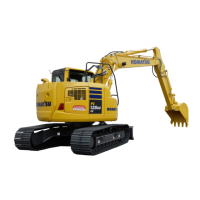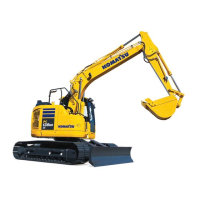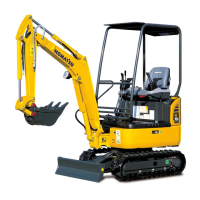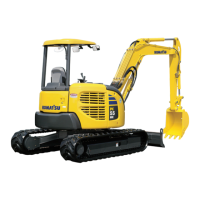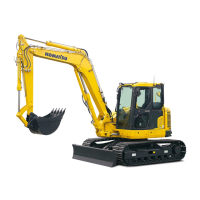SEN04118-02 40 Troubleshooting
2 PC130-8
Points to remember when troubleshooting 1
k Stop the machine in a level place, and check that the safety pin, blocks, and parking brake are
securely fitted.
k When carrying out the operation with 2 or more workers, keep strictly to the agreed signals, and
do not allow any unauthorized person to come near.
k If the radiator cap is removed when the engine is hot, hot water may spurt out and cause burns,
so wait for the engine to cool down before starting troubleshooting.
k Be extremely careful not to touch any hot parts or to get caught in any rotating parts.
k When disconnecting wiring, always disconnect the negative (–) terminal of the battery first.
k When removing the plug or cap from a location which is under pressure from oil, water, or air,
always release the internal pressure first. When installing measuring equipment, be sure to con-
nect it properly.
The aim of troubleshooting is to pinpoint the basic cause of the failure, to carry out repairs swiftly, and to pre-
vent reoccurrence of the failure. When carrying out troubleshooting, and important point is of course to
understand the structure and function. However, a short cut to effective troubleshooting is to ask the operator
various questions to form some idea of possible causes of the failure that would produce the reported symp-
toms.
1. When carrying out troubleshooting, do not
hurry to disassemble the components.
If components are disassembled immediately
any failure occurs:
q Parts that have no connection with the fail-
ure or other unnecessary parts will be dis-
assembled.
q It will become impossible to find the cause
of the failure.
It will also cause a waste of manhours, parts,
or oil or grease, and at the same time, will also
lose the confidence of the user or operator. For
this reason, when carrying out troubleshooting,
it is necessary to carry out thorough prior
investigation and to carry out troubleshooting
in accordance with the fixed procedure.
2. Points to ask user or operator
1) Have any other problems occurred apart
from the problem that has been reported?
2) Was there anything strange about the
machine before the failure occurred?
3) Did the failure occur suddenly, or were
there problems with the machine condition
before this?
4) Under what conditions did the failure
occur?
5) Had any repairs been carried out before
the failure? When were these repairs car-
ried out?
6) Has the same kind of failure occurred
before?
3. Check before troubleshooting
1) Is there any sign of irregularities of the
machine?
2) Make checks before starting day's work.
3) Make checks of other items.
4) Other maintenance items can be checked
externally, so check any item that is con-
sidered to be necessary.
4. Confirming failure
Confirm the extent of the failure yourself, and
judge whether to handle it as a real failure or
as a problem with the method of operation, etc.
a When operating the machine to reenact
the troubleshooting symptoms, do not
carry out any investigation or measure-
ment that may make the problem worse.
5. Troubleshooting
Use the results of the investigation and inspec-
tion in Items 2 – 4 to narrow down the causes
of failure, then use the troubleshooting table or
troubleshooting flowchart to locate the position
of the failure exactly.
a The basic procedure for troubleshooting is
as follows.
1] Start from the simple points.
2] Start from the most likely points.
3] Investigate other related parts or
information.
6. Measures to remove root cause of failure
Even if the failure is repaired, if the root cause
of the failure is not repaired, the same failure
will occur again.To prevent this, always investi-
gate why the problem occurred. Then, remove
the root cause.
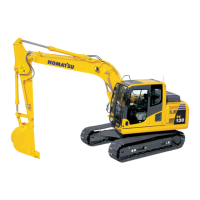
